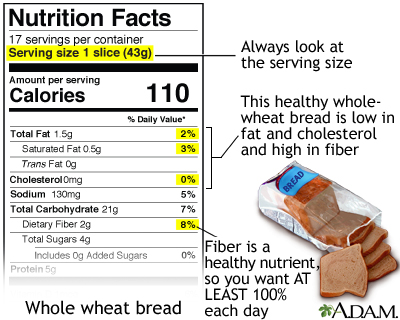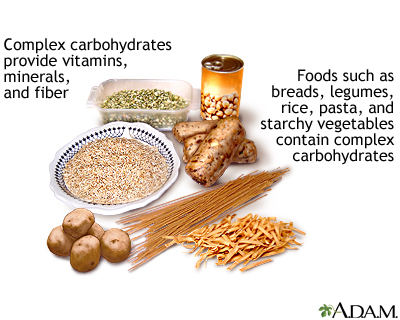Constipation - self-care
Images


Description
Constipation is when you do not pass stool as often as you normally do. Your stool may become hard and dry, and it can be difficult to pass.
Signs, Symptoms, and Causes
You might feel bloated and have pain, or you might have to strain when you try to go.
Some medicines, and even some vitamins, can make you constipated. You can get constipated if you do not get enough fiber, drink enough water, or get enough exercise. You can also get constipated if you put off going to the bathroom even though you have the urge to go.
Try to get to know your normal bowel movement pattern, so that you can prevent constipation and keep it from getting worse.
How to Relieve Constipation
Exercise regularly. Drink more water and eat more fiber. Try to walk, swim, or do something active at least 3 or 4 times a week.
If you feel the urge to go to the bathroom, go. Do not wait or hold it in.
You can also train your bowels to be more regular. It may help to go to the bathroom every day at the same time. For many people, this is after breakfast or dinner.
Eating When you Have Constipation
Try these things to relieve your constipation:
- Do not skip meals.
- Avoid processed or fast foods, such as white breads, pastries, doughnuts, sausage, fast-food burgers, potato chips, and French fries.
Many foods are good natural laxatives that will help you move your bowels. High-fiber foods help move waste through your body. Add foods with fiber to your diet slowly, because eating more fiber can cause bloating and gas.
Drink 8 to 10 cups (2 to 2.5 L) of liquids, particularly water, every day.
Ask your health care provider how much fiber to take each day. Males, females, and different age groups all have different daily fiber needs.
Most fruits will help ease constipation. Berries, grapes, peaches, apricots, plums, raisins, rhubarb, and prunes are just some of the fruits that may help. Do not peel fruits that have edible skins, because a lot of the fiber is in the skin.
Choose breads, crackers, pasta, pancakes, and waffles made with whole grains, or make your own. Use brown rice or wild rice instead of white rice. Eat high-fiber cereals.
Vegetables can also add fiber to your diet. Some high-fiber vegetables are asparagus, broccoli, corn, squash, and potatoes (with the skin still on). Salads made with lettuce, spinach, and cabbage will also help.
Legumes (navy beans, kidney beans, chickpeas, soybeans, and lentils), peanuts, walnuts, and almonds will also add fiber to your diet.
It is important to drink plenty of water when adding fiber to the diet or taking fiber supplements.
Other foods you can eat are:
- Fish, chicken, turkey, or other lean meats. These do not have fiber, but they will not make constipation worse.
- Snacks such as raisin cookies, fig bars, and popcorn.
You can also sprinkle 1 or 2 teaspoons (5 to 10 mL) of bran flakes, ground flax seeds, wheat bran, or psyllium on foods such as yogurt, cereal, and soup. Or, add them to your smoothie.
Laxatives, Stool Softeners, and Other Products
You can buy stool softeners at any pharmacy. They will help you pass stool more easily.
Your provider may prescribe a laxative to relieve your constipation. It may be a pill or liquid. Do not take it if you have severe stomach pain, nausea, or vomiting. Do not take it for more than 1 week without consulting your provider. It should start to work in 2 to 5 days.
- Only take a laxative as often as your provider recommends. Most laxatives are taken with meals or at bedtime.
- You can mix powder laxatives with milk or fruit juice to make them taste better.
- Always drink plenty of water (8 to 10 cups, or 2 to 2.5 L a day) when you are using laxatives.
- Store your laxative medicine safely in a medicine cabinet, where children cannot get to it.
- Do not take any other laxatives or medicines before talking with your provider. This includes mineral oil.
Some people get a rash, nausea, or a sore throat while taking laxatives. Women who are pregnant or breastfeeding and children under age 6 years should not take laxatives without the advice of a provider.
Bulk-forming laxatives such as Metamucil or Citrucel can help pull water into your intestines and make your stools more bulky.
When to Contact a Medical Professional
Contact your provider if you:
- Have not had a bowel movement in 3 days
- Are bloated or have pain in your stomach
- Have nausea or throw up
- Have blood in your stool
Related Information
Kidney removalRadical prostatectomy
Fecal impaction
Stroke
Multiple sclerosis
Stroke - discharge
Daily bowel care program
Multiple sclerosis - discharge
High-fiber foods
Constipation - what to ask your doctor
References
Camilleri M. Disorders of gastrointestinal motility. In: Goldman L, Cooney KA, eds. Goldman-Cecil Medicine. 27th ed. Philadelphia, PA: Elsevier; 2024:chap 122.
Koyle MA, Lorenzo AJ. Management of defecation disorders. In: Partin AW, Dmochowski RR, Kavoussi LR, Peters CA, eds. Campbell-Walsh-Wein Urology. 12th ed. Philadelphia, PA: Elsevier; 2021:chap 36.
Iturrino JC, Lembo AJ. Constipation. In: Feldman M, Friedman LS, Brandt LJ, eds. Sleisenger and Fordtran's Gastrointestinal and Liver Disease. 11th ed. Philadelphia, PA: Elsevier; 2021:chap 19.
BACK TO TOPReview Date: 7/15/2024
Reviewed By: Frank D. Brodkey, MD, FCCM, Associate Professor, Section of Pulmonary and Critical Care Medicine, University of Wisconsin School of Medicine and Public Health, Madison, WI. Also reviewed by David C. Dugdale, MD, Medical Director, Brenda Conaway, Editorial Director, and the A.D.A.M. Editorial team.

Health Content Provider
06/01/2025
|
A.D.A.M., Inc. is accredited by URAC, for Health Content Provider (www.urac.org). URAC's accreditation program is an independent audit to verify that A.D.A.M. follows rigorous standards of quality and accountability. A.D.A.M. is among the first to achieve this important distinction for online health information and services. Learn more about A.D.A.M.'s editorial policy, editorial process and privacy policy. A.D.A.M. is also a founding member of Hi-Ethics. This site complied with the HONcode standard for trustworthy health information from 1995 to 2022, after which HON (Health On the Net, a not-for-profit organization that promoted transparent and reliable health information online) was discontinued. |
The information provided herein should not be used during any medical emergency or for the diagnosis or treatment of any medical condition. A licensed medical professional should be consulted for diagnosis and treatment of any and all medical conditions. Links to other sites are provided for information only -- they do not constitute endorsements of those other sites. © 1997- 2025 A.D.A.M., a business unit of Ebix, Inc. Any duplication or distribution of the information contained herein is strictly prohibited.
